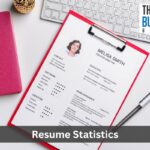While job seekers may feel anxiety over job interviews, recruiters and hiring personnel conducting job interviews are equally anxious and stressed over them.
Whether you’re a job seeker or a recruiter/hiring manager, you will find the following job interview statistics interesting and useful.
While both the interviewer and interviewee should be well-prepared for the interview process, they also shouldn’t overthink things.
Today, interviews are usually structured where comparable questions are asked. These interviews are more formal and precise.
Stress and anxiety isn’t something that happens with new job seekers or interviewers.
This also happens to some of the most experienced and professional interviewers and interviewees.
One of the intentions of this resource is to help alleviate some worry and stress on both sides of the interviewing table.
Without further commentary, let’s dive right in.
Post Contents
- 1 Key Statistics
- 2 Basic Job Interview Statistics in 2024
- 2.1 1. 69% of Job Seekers Are More Apt to Apply for Jobs Where the Employer Is Actively Managing Its Brand.
- 2.2 2. A 2013 Glassdoor Survey Revealed that 6 in 10% Employees Claimed that The Realities of Their New Jobs Were Different from The Expectations Established During Interviews.
- 2.3 3. 92% of Employers Are Using Social Media Networks to Look up Job Candidates Before Interviews.
- 2.4 4. 74% of Human Resource Managers Prefer to Use Structured Interviews Overall All Other Types of Job Interviews.
- 2.5 5. HR Managers Rate the Behavioral Interview Technique 89% Somewhat to Very Effective.
- 2.6 6. On Average, It Takes Between One and Three Interviews to Get a Job Offer.
- 2.7 7. According to 2019 Statistics, Top Job Candidates Are Hired by Recruiters Within 10 Days.
- 2.8 8. In 2015, Glassdoor Revealed that Each Posted Corporate Job Opening Draws 250 Resumes.
- 2.9 9. According to A Forbes Article, the Average Number of Job Seekers Who Apply for A Single Job Is 118.
- 2.10 10. The Most-Used Excuse for Missing a Job Interview Is for A Family Emergency.
- 3 Statistics According to Applicant Experience
- 3.1 11. Prior to The Pandemic, 94% of Interviewees Wanted Feedback About Their Performance.
- 3.2 12. 50% of Interviewees Claimed that Changes in The Interview Schedule Caused the Highest Level of Frustration Along with The Lack of Pay and Benefits Information.
- 3.3 13. 65% of job Candidates Claim that A Poor Interview Experience Causes Them to Lose Interest in The Job.
- 3.4 14. 47% of Interviewers Claim that They Would Not Give a Job Offer to A Candidate that Has Little to No Knowledge of The Organization.
- 3.5 15. Just 7% of Job Candidates Get a Phone Call About a Rejection for Employment.
- 4 Virtual Job Interview Statistics
- 4.1 16. According to a 2021 Indeed Survey, 82% of Employers Are Ow Using Virtual Interviews.
- 4.2 17. Virtual Interviews Have Improved Diversity in Applicants, According to 84% of Surveyed Employers.
- 4.3 18. 45% of Employment Recruiters Claim that Video Interviews Help to Speed up The Hiring Process.
- 4.4 19. Almost 50% of 400 Surveyed Job Seekers Said that They Prefer the Video Interview Experience Over Phone or In-Person
- 4.5 20. Once a Novelty, the Concept of Virtual Recruiting Has Become a Necessary Interviewing and Hiring Solution for Companies All Over the World.
- 5 Bonus Statistics
- 5.1 21. The Average Time-To-Hire Across Sectors Amounts to Three to Four Weeks.
- 5.2 22. If You’re 50 or Older It Will Take Much Longer to Find Work.
- 5.3 23. 63% of Employment Recruiters Claim They See a Shortage of Talent as One of The Biggest Obstacles.
- 5.4 24. Referred Candidates Are More Likely to Get Hired and Less Likely to Get Fired from A Job.
- 5.5 25. In 2022, The Average Cost per Hire Statistics for Companies Came to Nearly $4,700.
- 6 FAQs
- 7 Conclusion
- 8 Sources
Key Statistics
- 69% of job seekers are more apt to apply for jobs where the employer is actively managing its brand.
- 6 in 10 employees claimed that the realities of their new jobs were different from the expectations established during interviews.
- 92% of employers are using social media networks to look up job candidates before interviews.
- 74% of Human Resource managers prefer to use structured interviews overall all other types of job interviews.
- HR managers rate the behavioral interview technique 89% somewhat to very effective.
- On average, it takes between one and three interviews to get a job offer.
- Top job candidates are hired by recruiters within 10 days.
- Glassdoor revealed that each posted corporate job opening draws 250 resumes.
- The average number of job seekers who apply for jobs is 118.
- The most-used excuse for missing a job interview is for a family emergency.
Basic Job Interview Statistics in 2024

1. 69% of Job Seekers Are More Apt to Apply for Jobs Where the Employer Is Actively Managing Its Brand.
Your employer brand is more important than you might think regarding hiring employees.
If you manage your brand, you may get the attention of the 69% of job seekers who are apt to apply for a job if you’re actively managing your brand.
If you’re a company that hires employees, or you’re thinking about it, you need to take your branding a step further to include employer branding.
If you already have your company branding strategy in place, you have your basics done.
Your next step is to shape your employer branding into clear and concise terms.
(Glassdoor, HubSpot)
2. A 2013 Glassdoor Survey Revealed that 6 in 10% Employees Claimed that The Realities of Their New Jobs Were Different from The Expectations Established During Interviews.
Have you ever had a fantastic job interview that prompted you to take the offer and go to work for a company only to discover things weren’t as you were led to believe in the workplace?
I so you understand the 61% (6 in 10) employees who were disenchanted by the realities of a new job that didn’t meet their expectations based on the interview.
Additionally, 65% of men said that the job didn’t match the tone or realities of the job.
Likewise, 56% of women said that their new job wasn’t what they expected based on their interviews.
Overall, the parties responsible for making sure the job interview matches the realities of the job are both the employer and the job candidate.
(Glassdoor 2013)
3. 92% of Employers Are Using Social Media Networks to Look up Job Candidates Before Interviews.
What you do on your social media platforms matters more than you think when you’re a job seeker.
In fact, a whopping 92% of employers use social media platforms to look you up before they interview you.
The Muse says that you need to clean up your social profiles by eliminating excessive profanity, party pictures, and any articles, memes, or videos that could be considered offensive or divisive.
Always maintain a professional appearance on social platforms, hone your personal branding, be consistent, use your real name, try to keep your social accounts to one or two that are up-to-date and professional.
For instance, just have LinkedIn and Facebook profiles for your personal branding.
(The Muse)
4. 74% of Human Resource Managers Prefer to Use Structured Interviews Overall All Other Types of Job Interviews.
According to the statistics, almost three-quarters (74%) of HR managers prefer the structured interview method overall other interview techniques.
Why? Because structured interviews are formal and use parallel, or similar sets of questions for all job candidates.
HR managers and hiring managers like this interview method for its fairness and uniform-centric technique.
Consequently, 73% of HR managers also emphasize behavioral interviews.
The less preferred interview methods include phone screenings (57%), panel interviews (48%), and case study or assignment-based interviews (32%).
(LinkedIn Global Recruiting Trends 2018, SeedScientific)
5. HR Managers Rate the Behavioral Interview Technique 89% Somewhat to Very Effective.

While surveyed interviewers preferred the structured interview technique over all other interview types, they found that the behavioral interview method to be the most effective over structured interviews by 1%.
In essence, hiring managers almost equally prefer structured and behavioral interview methods, and believe that both are effective and sound techniques.
Oddly, 84% of HR managers found the assignment-based/case study interview method to be effective, though only 32% preferred this method.
Likewise, while 57% said they prefer phone screenings, 70% found this interview technique somewhat or very effective.
The interview panel method may have scored the interest of only 48% of hiring managers, but 79% believe they are somewhat or very effective.
(LinkedIn Global Recruiting Trends 2018)
6. On Average, It Takes Between One and Three Interviews to Get a Job Offer.
It’s not unusual to take from one, or up to four job interviews to obtain an offer.
This is because the hiring process takes time, so they evaluate the interviews for each round, eliminate candidates that don’t match the needs or requirements for the position, and sometimes, it’s simply a tough decision when there are several qualified, skilled candidates.
Indeed, the job search platform says that between one and three interviews fall into the most successful category.
However, InsightGlobal says that it can take between two and four interviews before a candidate receives an offer. Basically, they are sharing similar data,
Naturally, the more interview callbacks you get, the higher your chances are for getting an offer.
Whatever you do, don’t give up. Getting an offer can take several days to weeks per company.
(Indeed, InsightGlobal)
7. According to 2019 Statistics, Top Job Candidates Are Hired by Recruiters Within 10 Days.
Not every job candidate must wait weeks for a rejection or offer from an employer after the interview process has ended.
The most skilled and high-quality talent gets hired within 10 days.
On average, a job candidate may hear from the hiring company within one to two weeks after interviewing.
In 2018, the average “time-to-hire” came to 38 days, which is lower than the 41 days for 2015.
Some companies may hire a candidate within 24-48 hours.
Job offers have a wide range of timeframes, which are dependent upon the job type, the number of applicants, and other factors.
(2019 Jobvite Benchmark Report, Indeed 2, Workonic)
8. In 2015, Glassdoor Revealed that Each Posted Corporate Job Opening Draws 250 Resumes.
It’s common for corporate jobs posted on websites and other venues to receive at least 250 resumes.
However, only four to six job candidates will be called in for an interview. Only one of these four to six candidates will get a job offer.
So, if you’ve been called in for an interview over the past few years, you know you’re one of a few selected to interview for a corporate job.
The job of assessing each candidate, from evaluating the 250 resumes to interviewing the four to six invited to the interview, takes several days to complete before an offer is provided.
Also due to this high volume of resumes, poor hiring decisions may occur.
For recruiters and hiring managers, online test assessments can help to rule out candidates faster.
(Glassdoor 2015)
9. According to A Forbes Article, the Average Number of Job Seekers Who Apply for A Single Job Is 118.
While this data is from 2015, it’s still likely accurate, or maybe a little high since the pandemic.
We will find out more as the 2022 and 2023 interview statistics are available.
How many of these 118 applicants get interviewed? The percentage is 20%, so 23 to 24 applicants may get called to interview.
This also means that you should expect to have competition for each job you apply for no matter what the industry.
The 20%, or 23-24 applicants that get invited to an interview represents one in five people.
This is useful information to have if you’re a job seeker.
(Forbes 2013)
10. The Most-Used Excuse for Missing a Job Interview Is for A Family Emergency.

Out of nine listed excuses given for missing a job interview, claiming the applicant had a family emergency is number one.
This excuse is used, true or not, because it’s difficult to prove or dispute.
What employer or hiring manager wants to be known as the person who told someone that a family emergency is not a good reason to miss the interview?
Other excuses behind family emergencies include helping a friend in distress, car crash or car trouble, illness, took a freelance gig, not feeling up to it, someone told me the job was taken, a work emergency, and finally the truth.
Honesty really is the best policy. We don’t advocate telling anything less than or more than the truth about missing a job interview.
You may or may not get a postponement.
(College Recruiter)
Statistics According to Applicant Experience
In this part of the article, we will discuss a few statistics related to job candidate experience.
11. Prior to The Pandemic, 94% of Interviewees Wanted Feedback About Their Performance.
Since we don’t have access to newer data about how many interviewees wanted feedback about their interview performance, we are using LinkedIn’s 2014 The Ultimate List of Hiring Statistics for some answers.
In this report, 94% of skilled talent wanted to get feedback on their interview.
Unfortunately, only 41% have ever gotten interview feedback.
If you’re in the position to interview job applicants, you should know that providing interview feedback plays a significant role in offering a positive job candidate experience.
It can help you streamline the hiring process and give the candidate a pleasant experience.
You must consider how this impacts the long run of the company and its hiring practices.
It’s wise for an organization to have a database where this feedback is recorded to help the company learn more about the talent they want to hire.
It also helps for future feedback brainstorming.
(LinkedIn 2014)
12. 50% of Interviewees Claimed that Changes in The Interview Schedule Caused the Highest Level of Frustration Along with The Lack of Pay and Benefits Information.
Since this section is all about the job candidate, it involves discussing the overall interview experience.
The two top things that frustrate job candidates the most about interviews include a change in scheduling and the lack of information regarding benefits and pay.
Unless you have no other choice, avoid making interview schedule changes, and be sure to accurately and thoroughly discuss employee pay and benefits in the interview.
Each of these issues were the highest in one study and came in at 50% each.
Moreover, untimely responses (47%) and the lack of job duties and responsibilities discussed (46%) are considered frustrating for the job candidate.
(Lumen Learning)
13. 65% of job Candidates Claim that A Poor Interview Experience Causes Them to Lose Interest in The Job.
Have you ever had such a bad interview that you completely lost interest in the job? If so, you are one of 65% of candidates that say this has a negative impact on the interview experience and the company.
Just because this information is a few years old doesn’t make it less valid in today’s interviewing world.
It certainly can and does have a negative effect on a company and their interviewing process.
In fact, the interview experience and process can either make or break a job applicant’s decision to accept an offer from you.
If they are a high-quality candidate with the best skills for the position, you could lose top talent for this issue alone.
The overall interview experience is something every interviewer needs to consider with each candidate.
(LinkedIn 2017)
14. 47% of Interviewers Claim that They Would Not Give a Job Offer to A Candidate that Has Little to No Knowledge of The Organization.
If you’re a job candidate who has an invitation to an interview with a company, you need to learn as much as you can before you go on that interview.
Knowing as much as you can remember about a company can boost your interview experience and the likelihood of getting a second interview.
This data is from a UK blog, but it holds true in the United States and in most companies across the globe.
It doesn’t take much time to get to know the company from which you are trying to get a job.
Taking that little bit of time to learn some highlights of the company, its mission, and other information can go a long way to a successful interview.
(Twin Employment & Training)
15. Just 7% of Job Candidates Get a Phone Call About a Rejection for Employment.

If you really want to improve the interview experience for applicants, a phone call is the most personal and thoughtful way to let them know they didn’t get the job.
Only 7% of interviewees get a phone call.
While it’s easier to do it via email or text, a phone call is always more personal.
If you want to keep it personal for your applicant, alternatively you can write a personalized email expressing your regrets and best wishes.
If in the future, you want to hire a candidate you once rejected, they will remember that you cared enough to go the extra mile to make that phone call or write that personalized email.
(LinkedIn 2021)
Virtual Job Interview Statistics
This section will be all about the virtual setting for job interviews.
This will include video interviews and virtual face-to-face interviews.
16. According to a 2021 Indeed Survey, 82% of Employers Are Ow Using Virtual Interviews.
The virtual interview ideal was available before the pandemic among companies with remote work.
However, now 82% of employers are using virtual interviews since the pandemic regardless of whether it’s remote.
Likewise, another 93% of surveyed employers say they plan to start using virtual interviews moving forward.
This interview style may have been made popular during the lockdowns, but enterprise companies, small business, and medium sized businesses all agree they plan to use this in the future.
Additionally, 77% of employers using virtual interviews say that it enhances the job candidate experience especially since they can interview from anywhere at any time.
Interviewees also say they feel less intimidated in virtual interviews.
(Forbes 2021, Indeed Survey)
17. Virtual Interviews Have Improved Diversity in Applicants, According to 84% of Surveyed Employers.
Besides improving the candidate experience, virtual interviews have also improved the instances of a more diverse applicant pool for employers.
In fact, 84% of employers who use virtual interviews say that they have seen an uptake in diverse candidates.
Something that has helped companies is the fact that they are promoting to a diverse audience in their job posts and their virtual interview option.
In the survey, 30% of employers claim that they are prioritizing inclusive job listing descriptions.
Didn’t we mention how company branding regarding their hiring and interview practices?
(Indeed Survey)
18. 45% of Employment Recruiters Claim that Video Interviews Help to Speed up The Hiring Process.
Does it surprise you that recruiters are saying that video interviews are helping to speed up the hiring process?
Also, only 22% of employers said they would stop using video interviews and go back to conventional in-person interviews when the lockdowns were done.
Something special about video interviews is that they can be and are usually recorded so that the hiring person can go back and look at candidates they were considering.
It helps to improve the decision-making process.
Before the pandemic, 22% of employers were already conducting interviews via video.
(OnRec)
19. Almost 50% of 400 Surveyed Job Seekers Said that They Prefer the Video Interview Experience Over Phone or In-Person
The reason for job seekers liking the video interview experience better is for the convenience, ease of use, and because this process opens the door to more possibilities across the nation and the globe for jobs.
Also, companies that are using video interviews are being touted as innovative, tech-savvy, and they are keeping up with the times.
Keeping up with innovations in the interviewing and hiring process is impressive to the upcoming generations. It’s like building your future audience.
Out of 20,000 candidates that completed a Spark Hire video interview, they rated their experiences 4.5 out of 5 stars.
(Spark Hire)
20. Once a Novelty, the Concept of Virtual Recruiting Has Become a Necessary Interviewing and Hiring Solution for Companies All Over the World.

We know that there were some innovative companies that have been using virtual interviews since before the pandemic, but since then, it’s no longer just a novelty. It’s a necessity.
The heavier use of virtual interviews showed employers and recruiters that they can speed up the interview process and make it more efficient.
It’s an ideal option when you can’t meet in person due to safety concerns or when you’re separated by distance.
We think you can count on virtual interviews and recruiting to be a permanent ideal.
(icims)
Bonus Statistics
In this section, we’ll address 10 interesting bonus statistics for our readers before we conclude.
21. The Average Time-To-Hire Across Sectors Amounts to Three to Four Weeks.
While most job candidates expect to hear back with an offer of employment in a week or less, the average is three to four weeks.
The hiring process is encumbered with applicants, company policies, government regulations, and lengthy paperwork.
Also, the period for an offer to be given relies on the industry.
Depending on the industry you’re looking for work in, over 40% of recruiters spend over two full weeks on the interview process alone.
Only 25% claim to hired talent in under two weeks.
So, if you’re expecting to go to work tomorrow, it’s unlikely to happen in most industries.
You may need to set your sites lower if you want to get to work fast.
(Yello)
22. If You’re 50 or Older It Will Take Much Longer to Find Work.
The unemployment rate for those over 50 may be lower than it is with younger workers, but once older employees experience forced retirement, layoffs, or other job loss, it’s harder for them to find a new job.
In March 2020, the average unemployment duration for job seekers between 55 and 64 was over 20 weeks (6 months equals 26 weeks to put that in perspective).
The overall average among workers is 17.5 weeks.
While age discrimination may be present, you may be told you’re overqualified or that you lack technical skills.
(U.S. News)
23. 63% of Employment Recruiters Claim They See a Shortage of Talent as One of The Biggest Obstacles.
Since the pandemic, the shortage of talent has been on the rise.
There are many reasons for it that we won’t address in this article, but maybe in a future one.
Recruiters were surveyed and they responded about their challenges in hiring.
The shortage of talent is one of the biggest challenges according to 63% of the responses.
However, 76% of recruiters said that attracting the right candidates is the greatest challenge.
This, plus the fact that the top candidates are taken within 10 days, makes recruiting more difficult.
Another hiring challenge, according to recruiters, is that 75% of job seekers claim that they wouldn’t accept a job offer from a company with a poor reputation.
(LinkedIn 2022)
24. Referred Candidates Are More Likely to Get Hired and Less Likely to Get Fired from A Job.
Employee referrals make up some of the job candidates for various jobs.
Statistics show that employee referrals are 5 times more apt to get hired than the average job applicant.
Around 78% of recruiters believe that referrals are the ideal method for finding qualified and skilled talent in today’s employment setting.
Additionally, referred candidates are 15 times more likely to get the job over an applicant that came across the job posting.
It doesn’t hurt that job satisfaction among referred employees is higher, which means they stay with a company longer.
(Go Remotely, Legaljobs)
25. In 2022, The Average Cost per Hire Statistics for Companies Came to Nearly $4,700.

It’s no wonder that there seems to be so many challenges and difficulties in today’s workplace related to the hiring process.
In 2022, the average cost-per-hire amounted to almost $4,700.
Imagine the costs when you need to replace or hire 10 or more new employees.
According to E.L. Goldberg, 30% to 40% of the costs are hard costs, while 60% are soft costs.
As a result, if you’re hiring talent for a job that pays $60,000 per year, the costs incurred can come to $180,000 plus just to fill that job.
(SHRM)
FAQs
How Many Job Candidates Get to The Last Interview Round?
The average number of candidates that make it to the final round of interviews is 3.
This is due to the high competition factor and the fact that 98% of job candidates don’t even get to interview at all.
Interestingly, 75% of job applicants don’t have the right qualifications for the position.
Therefore, if you have the skills from the job description, you already have an edge.
How Many Interview Rounds Are Common?
The overall average number of interviews is 3 before a job offer is given.
Only 22% of recruiters claim that the average number of interviews is 4 before you can get a job.
Another 9% claim it can take 5 or more interviews.
How Long Is the Average Interview Process?
Statistics show that the average interview process can take 45 minutes.
Also, it can take at least five days to hear back from an employer or recruiter about a job.
While the interview process can take longer, 40% of employment recruiters claim that they speed over two weeks through the interview process.
How Much Does the Chance of Getting a Job After the Second Interview Rise?
The chances of getting a job after you’re called back for a second interview is between 25% and 50%.
The process of elimination is what makes your chances better in this process.
However, we recommend being fully prepared since the competition is high.
Conclusion
If you’re a recruiter or an employer seeking quality talent, these statistics should help you improve the interview process and experience.
If you’re one of the millions of job seekers in the United States, you now have some idea of the competition, how long it takes, and the overall interview process.
The costs of replacing or hiring new workers is literally astronomical in today’s workplace.
Therefore, it’s more important than ever to be able to attract top talent.
It’s understandable that companies want to recruit top talent that will be there for the long haul.
Corporations are putting a lot of money into training, upskilling, and other job training, so they need stable workers.
Finally, the pandemic may have halted job growth, but it sparked new ways to interview and hire people that are more efficient and effective in most industries.
They are seeking better ways to cut costs and attract top talent.
We hope that if you’re a recruiter, employer, hiring manager, or a job seeker, these job interview statistics have helped you learn more about the current state of employment and how you can overcome the obstacles that may stand in your way.






























